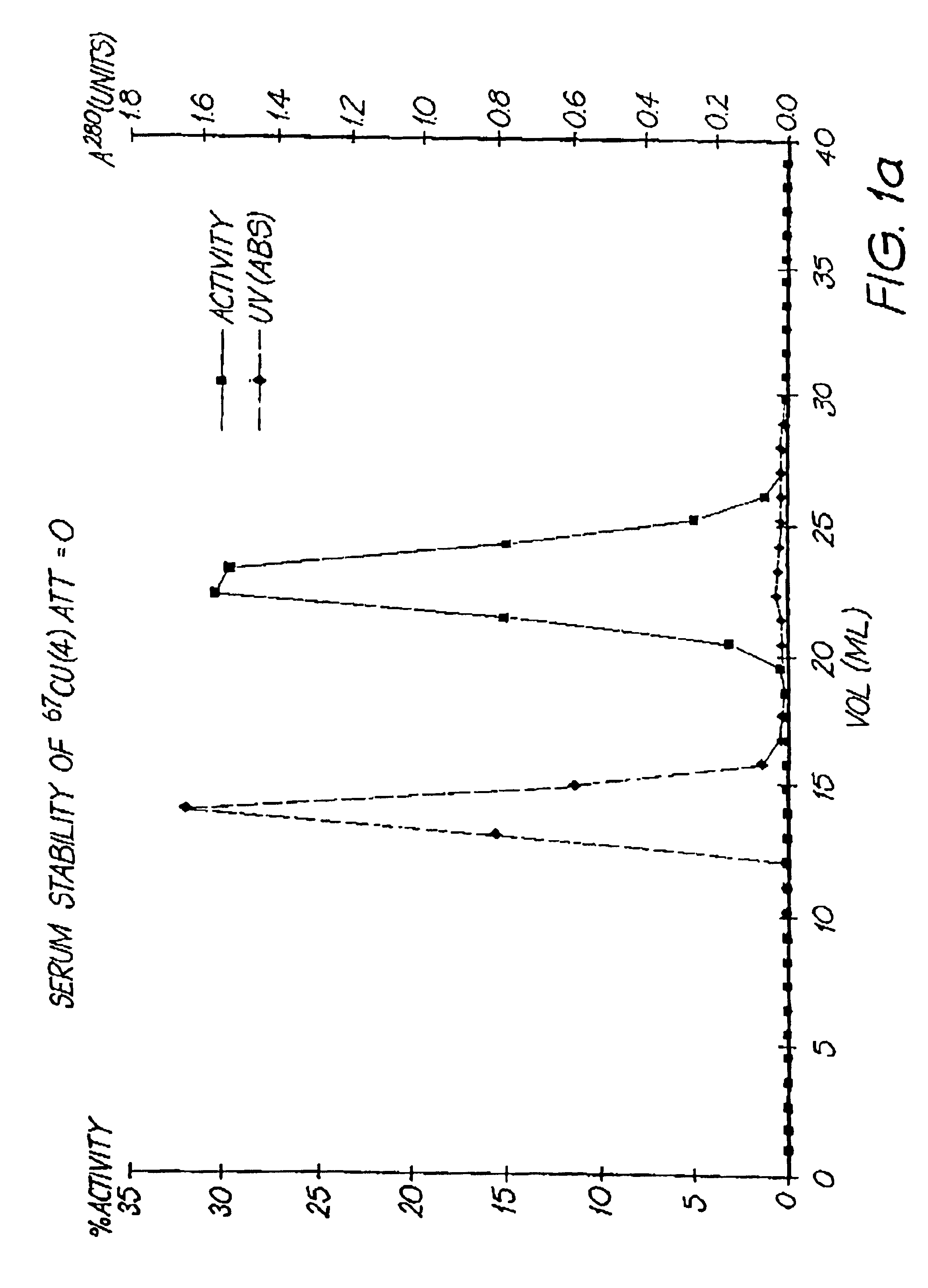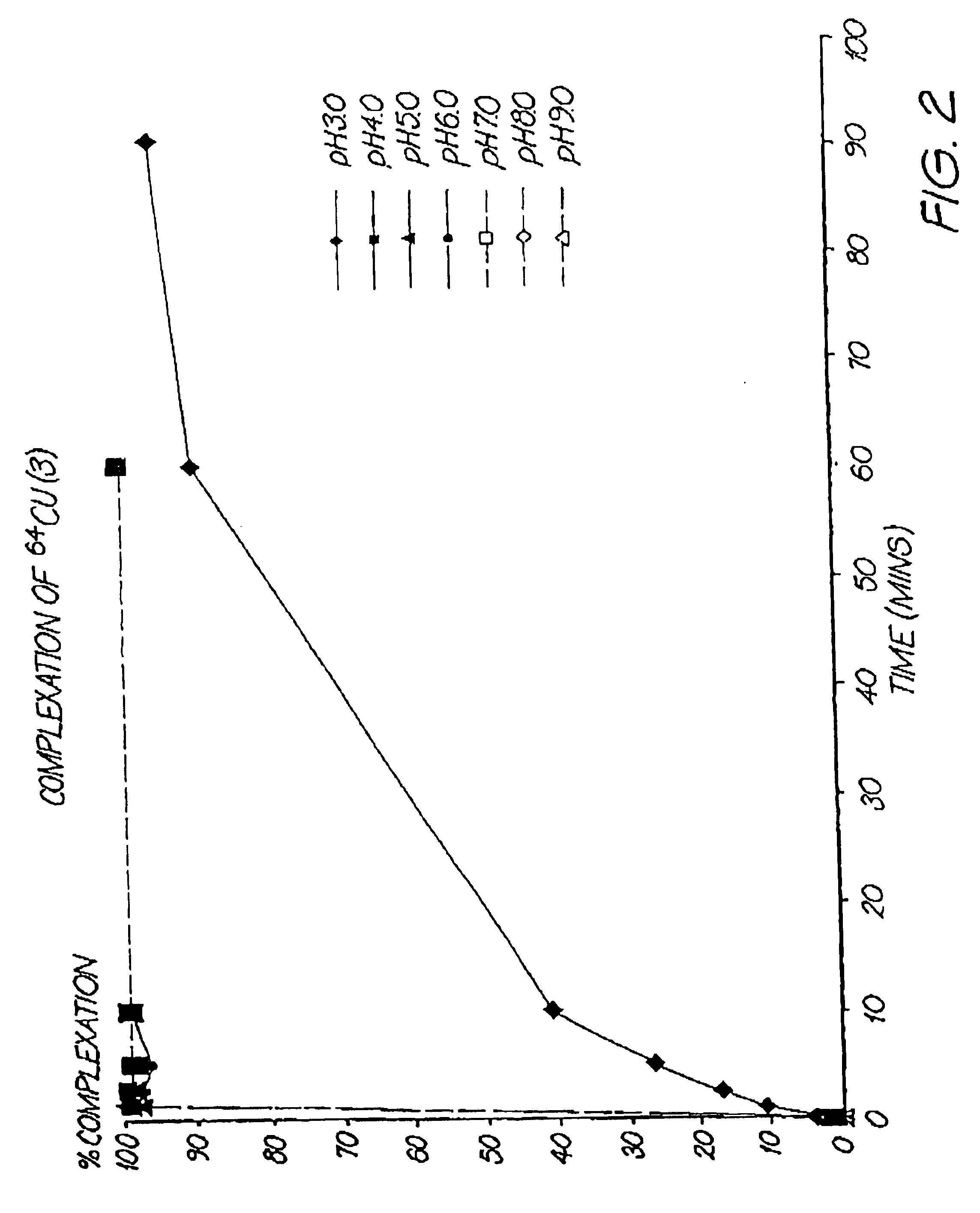Cryptate compounds and methods for diagnosis and therapy
a technology of cryptate compounds and compounds, applied in the field of cryptate compounds, can solve the problems of non-specific biodistribution of known radiopharmaceuticals, problems such as potential complications in diagnostic and therapeutic applications, and problems such as the nature of radiopharmaceuticals
- Summary
- Abstract
- Description
- Claims
- Application Information
AI Technical Summary
Benefits of technology
Problems solved by technology
Method used
Image
Examples
example 1
Preparation of Compound (3)
Preparation of compound (3) is illustrated in Schemes 1 and 2.
A. Preparation of Compound (2)
Compound (2) is prepared by Schiff base reaction of compound (1) with p-nitrobenzaldehyde. Synthesis of compound (1) is described in Aust. J. Chem (1994) 47, 143-179. A copper complex of (1) is dissolved in dry ethanol (2.4 mmoles in 100 mls) and p-nitrobenzaldehyde (2.2 mmoles) is added. The reaction mixture is evaporated to dryness and reconstituted (with dry ethanol) twice to remove any water. The reaction mixture is once again reconstituted in dry ethanol and stirred for 30 mins under nitrogen gas. Sodium cyanoborohydride (25 mmoles), glacial acetic acid (2 mmoles) and activated 3 Å molecular sieves are added and the reaction is allowed to stir overnight. The mixture is filtered, evaporated to dryness and extracted with chloroform and water (100 ml:200 ml). The water layer is diluted to 2 L, sorbed onto SP Sephadex C25 and eluted with 0.3 M sodium acetate. (Sch...
example 2
Complexation of 64Cu by Compound (3)
The effect of pH on complexation of 64Cu by compound (3) was investigated. Compound (3) was diluted into buffers of pH 3.0, 4.0, 5.0, 6.0, 7.0, 8.0 and 9.0. A sufficient amount of 64Cu was added and the rate of complexation was monitored at (t=1, 2.5, 5, 10, 60 and 90 mins) (see method below) by Instant Thin Layer Chromatography (ITLC-SG). Complete complexation (>98%) was achieved within 1 min for all pH ≧4.0. The rate of complexation at pH 3.0 was slower. (FIG. 2).
Monitoring Complexation by ITLC-SG
ITLC-SG strips (10 cm×0.8 cm) were spotted with ˜1 μL of reaction mixture 1 cm from the bottom of the strip (origin) and were developed in a solvent containing 0.1 M sodium acetate (pH 4.5): ethanol=9:1. 64Cu-compound (3) remains at the origin (Rf=0.0), and “free”64Cu appears at the solvent front (Rf=1.0).
A typical method of radiolabelling the ligand is achieved by adjusting the pH of an aqueous solution of the ligand to pH 5.0. Sufficient volume of 64 / ...
example 3
Serum Stability of 67Cu Complex of Compound (4)
Serum stability studies were conducted by incubating a 67Cu complex of related species (4) in human plasma at 37° C.
At various time intervals, the complex was separated from the plasma by size exclusion chromatography and the complex breakdown was assessed. Results indicated that no more than 2% of the copper is lost from the chelator during the first 174 hours at 37° C. (FIGS. 1a and 1b).
PUM
| Property | Measurement | Unit |
|---|---|---|
| structure | aaaaa | aaaaa |
Abstract
Description
Claims
Application Information
 Login to view more
Login to view more - R&D Engineer
- R&D Manager
- IP Professional
- Industry Leading Data Capabilities
- Powerful AI technology
- Patent DNA Extraction
Browse by: Latest US Patents, China's latest patents, Technical Efficacy Thesaurus, Application Domain, Technology Topic.
© 2024 PatSnap. All rights reserved.Legal|Privacy policy|Modern Slavery Act Transparency Statement|Sitemap



